2015
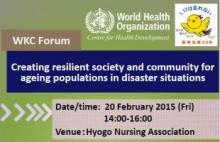
WKC Forum: Creating resilient society and community for ageing populations in disaster situations
17 January 2015 marks the 20th-year anniversary of the Great Hanshin-Awaji Earthquake in 1995. Commemorating this event, and to synthesize some of its lessons, the WHO Centre for Health Development (WHO Kobe Centre – WKC) will organize an open, public forum on “Creating resilient society and community for ageing populations in disaster situations” on Friday, 20 February in Kobe.
The 2005 Hyogo Framework for Action (HFA) was adopted by all countries to address disaster risk reduction, while agencies such as WHO, UNDP and UNISDR, and others have developed specific guidance for the various aspects of the disaster continuum.
Member States have evaluated the HFA and are negotiating an update and revision at the upcoming March 2015 World Conference for Disaster Risk Reduction in Sendai, Japan. Many lessons have been learned in the past decade, including from the Great East Japan Earthquake (GEJE), and from so many other disasters across the world. This has led to a great need to share lessons on how to achieve the current goal of creating a resilient society and community.
Japan has the largest proportion of older adults in the world. As a result, aged populations were much more affected in the 1995 Great Hanshin-Awaji Earthquake and in the 2011 GEJE. There are many implications from the vulnerability of older populations that help us better understand how to better prepare, respond, and support survivors. This has an impact on one of the biggest issues confronting communities that is caring for survivors that include health, psycho-social, and physical issues. As important members of the community, older persons can help lead and contribute to resilient communities.
In this Forum, five Japanese experts from the fields of medical care, nursing and from local government and from WHO will discuss how to develop a resilient society and community that is better prepared for natural disasters and can further support the survivors of natural disasters drawing from experiences of past disasters. Open discussion including questions from the audience will follow the presentations.
Date & venue:
20 February 2015 (Friday) 14:00–16:00
Hyogo Nursing Association
Programme:
Language: Japanese
14:00–14:10 Opening remarks
14:10–15:25 Presentations
15:25–15:55 Discussion
15:55–16:00 Closing remarks
Speakers:
(in order of presentations)
"Older peoples’ health after the Great East Japan Earthquake: From the epidemiological perspective"
Dr Satoko Mitani
Associate Professor, Unit for Liveable Cities, Kyoto University
"Ageing society and disaster: report form global perspective"
Dr Mayumi Kako
Consultant, WHO Kobe Centre
"Older people's health after the Hanshin Awaji Earthquake: Learning from community support activities"
Dr Kazuhisa Okamoto
Head of Protection Section in Tarumi Ward, Tarumi Ward Office, City of Kobe
"Supporting people's health through the activity of Machi-no-Hokenshitsu (Public health room in communities)"
Professor Aiko Yamamoto
Director, WHO Collaborating Center for Nursing in Disasters and Health Emergency Management
University of Hyogo
"Disaster recovery in the ageing society: the case of the Great East Japan Earthquake"
Dr Sae Ochi
Director of Internal Medicine, Soma Central Hospital
For more details:
2014
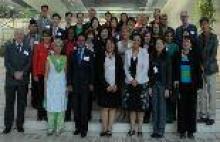
Intersectoral Action for Health (ISA)
Intersectoral action for health (ISA) refers to the inclusion of several sectors in addition to the health sector when designing and implementing public policies to improve quality of life. To promote ISA, WKC developed a guidance booklet titled “Intersectoral Action on Health, a path for policy-makers to implement effective and sustainable action on health” in 2011 and have since documented ISA experiences through case studies. The guidance booklet is now in preparation for revision.
In May 2014, WKC held the Expert Consultation to collectively review and develop recommendations for the revision of the guidance booklet. The meeting report highlights recent global developments and experiences in ISA and a synthesis of the recommendations for the revision of the booklet.
In addition, new recent publications on ISA case studies in local governments conducted by WKC have been published. The findings provide valuable insight into the common challenges and success factors for local governments to mobilize ISA for better health outcomes.
Expert consultation meeting report
Intersectoral action: local governments promoting health
- Intersectoral action: local governments promoting health
Rantala R, Bortz M, Armada F. Intersectoral action: local governments promoting health. Health Promot Int. 2014 Jun;29 Suppl 1:i92-i102. doi: 10.1093/heapro/dau047.
Liverpool Active City
Intersectoral health policy in Varde, Denmark
- Intersectoral health policy in Varde, Denmark case study report
- Intersectoral action for health: the experience of a Danish municipality
Larsen M, Rantala R, Koudenburg OA, Gulis G. Intersectoral action for health: the experience of a Danish municipality. Scand J Public Health. 2014. doi: 10.1177/1403494814544397.

Survey of Needs for Assistive and Medical Devices for Older People in Six Countries of the WHO Western Pacific Region
WHO Kobe Centre prepared the report of a survey of needs for assistive and medical devices for older people in six countries of the Western Pacific Region: China, Japan, Malaysia, the Philippines, the Republic of Korea and Viet Nam. The survey was commissioned to Motivation Australia and the Royal Australasian College of Surgeons by WHO.
Innovations in health technologies, and associated health and social delivery systems, are critical to preventing and managing functional and cognitive decline that older populations increasingly experience, as well as to reduce long-term institutionalization.
The research identifies priority assistive and medical devices for older people, provides a better understanding of contributing factors for their availability and proposes approaches to improve access to high quality assistive and medical devices at an affordable cost in high-income and middle-income countries.
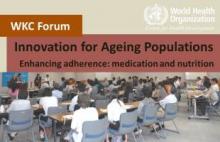
WKC Forum report: Innovation for Ageing Populations – Enhancing adherence: medication and nutrition
The United Nations' International Day of Older Persons is celebrated every year on 1 October. In commemoration of this year's International Day of Older Persons, the WHO Centre for Health Development (WHO Kobe Centre – WKC) will organize in Kobe an open forum on “Innovation for Ageing Populations – Enhancing adherence: medication and nutrition”. 60 participants were in attendance to learn about the latest innovations for older populations to improve medical adherence and the well-being of elderly patients; and the useful nutrition insight for older adults.
The population of older adults worldwide is growing rapidly. This demographic transition has also ushered forth an epidemiological transition. Noncommunicable diseases (NCDs) have become the leading cause of death globally, and account for 50% of all disability. Japan is particularly emblematic of this trend, having the largest proportionate population of older adults in the world, and where NCD accounts for nearly 80% of all mortality.
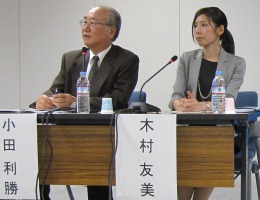 Living longer will entail that many of us will have to live with conditions requiring medication and nutrition regimen. In this context, a patient’s therapeutic behaviours used to be judged passively based on the concept of “compliance” – how closely a patient follows the treatment prescribed by a doctor. Today, more important to supporting treatment success depends on the extent to which a person’s behaviour – taking medication, following a diet, and/or executing lifestyle changes – corresponds with agreed recommendations from a health care provider. This is the concept of “adherence”.
Living longer will entail that many of us will have to live with conditions requiring medication and nutrition regimen. In this context, a patient’s therapeutic behaviours used to be judged passively based on the concept of “compliance” – how closely a patient follows the treatment prescribed by a doctor. Today, more important to supporting treatment success depends on the extent to which a person’s behaviour – taking medication, following a diet, and/or executing lifestyle changes – corresponds with agreed recommendations from a health care provider. This is the concept of “adherence”.Many of the health challenges that manifest with ageing can be prevented and/or controlled. However, adherence to treatment becomes more challenging with age, cognitive and functional decline and with the increasing complexity of medical regimens to maintain health and quality of life. Adherence to therapies is a primary determinant of treatment success. Poor adherence attenuates optimum clinical benefits and therefore reduces the overall effectiveness of health systems.
Similarly, as people age, their nutritional requirements evolve and may be impaired by ill-health, side effects of multiple medication, changing lifestyles and lack of knowledge. Linkages between diets, medical adherence and improved health condition emerge as important elements of healthy ageing.
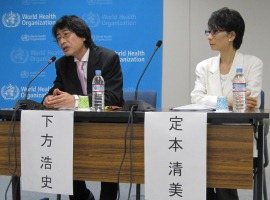 At this forum, four Japanese experts in the field of gerontology, medication, and nutrition, presented their respective evidence-based body of work and strategic recommendations in moving forward on addressing current and emerging challenges on medical adherence and nutrition in ageing populations.
At this forum, four Japanese experts in the field of gerontology, medication, and nutrition, presented their respective evidence-based body of work and strategic recommendations in moving forward on addressing current and emerging challenges on medical adherence and nutrition in ageing populations.
Dr Oda, Professor Emeritus of Kobe University, focused on defining the concept of adherence and highlighted the changing perceived and expected roles of older people in Japan. Dr Sadamoto, Professor at the Yokohama College of Pharmacy, presented the findings of her latest research on monitoring patient’s drug adherence with innovative technologies. Dr Shimokata, Professor at Nagoya University of Arts and Sciences, focused on the need for older people to improve dietary habits as a way to improve well-being. Dr Kimura, Research Fellow at Kyoto University, presented on declining food diversity in older people and the challenges it creates for older people coping with chronic diseases.
The panel discussion was lively led by Dr Oda with the speakers, and motivated by comments and questions from the participants. The discussion primarily covered main topics focusing on medical adherence as well as nutrition requirements for the elderly. To improve and enhance adherence, the discussion concluded that there is an urgent need to increase collaboration across sectors (e.g. doctors, nurses, pharmacists, nutritionists, community support, etc.) for better responding the current and emerging needs of older adults.

Programme & Speakers
Presentations (Japanese)
- “Medical and nutritional adherence: Wellbeing of the elderly in Japan”
Dr Toshikatsu Oda, Professor Emeritus, Kobe University Kobe
- “Innovations in monitoring medical adherence in elderly patients in Japan”
Dr Kiyomi Sadamoto, Professor, Department of Clinical Pharmacy
Yokohama College of Pharmacy
- “Nutrition and health maintenance in Japanese elderly”
Dr Hiroshi Shimokata, Professor, Graduate School of Nutritional Sciences
Nagoya University of Arts and Sciences
- “Adequate dietary intake in later life”
Dr Yumi Kimura, Post-Doctoral Research Fellow of the Japan Society of the Promotion of Science
Center for Southeast Asian Studies (CSEAS), Kyoto University
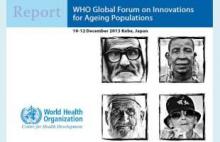
WHO Global Forum on Innovations for Ageing Populations
In 2013, the World Health Organization (WHO) established the Global Forum on Innovation for Ageing Populations as an information exchange platform for diverse stakeholders to address the challenge of meeting the needs of older people in low resource settings with frugal innovations.
The Global Forum brought together more than 170 expert participants from 21 countries for 3 days of rich discussion and debate, in order to meet the following objectives: exchange information, views and lessons from key operations and health systems research concerning technological and social innovations for ageing populations; highlight findings and solutions through specific examples of successful, scaled-up innovations; and identify key future priorities for WHO and its partners in support of innovations for ageing populations.
The Report provides a synthesis of the presentations, debates, and conclusions of the Global Forum on Innovation for Ageing Populations held on 10-12 December 2013 in Kobe, Japan.

Revision of Urban HEART
More than a billion people have been added to urban areas since 2000. Ninety percent of this rise has taken place in developing countries. By 2050, it is estimated that 6.4 billion people will live in urban areas with nearly 2 billion living in slums. Inequities in wealth, health, and access to resources will continue to be a key concern in urban areas.
Till date, the WHO Kobe Centre has worked with cities from 40 countries to implement the Urban Health Equity Assessment and Response Tool (Urban HEART). The Centre has also documented experiences on using Urban HEART including the recent publication of two journal papers in 2014.
At present, the Centre is focused on revising Urban HEART based on feedback from city experiences, expert recommendations, and independent evaluations. The Centre would like to invite all who have used Urban HEART in any capacity to share their ideas and suggestions for revising the tool.
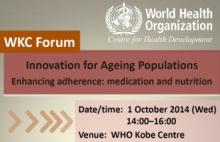
WKC Forum: Innovation for Ageing Populations – Enhancing adherence: medication and nutrition
The United Nations' International Day of Older Persons is celebrated every year on 1 October. In commemoration of this year's International Day of Older Persons, the WHO Centre for Health Development (WHO Kobe Centre – WKC) will organize in Kobe an open forum on “Innovation for Ageing Populations – Enhancing Adherence to Medication and Nutrition”.
The population of older adults worldwide is growing rapidly. In most nations today, the fastest growing demographic segment is the population of adults over the age of 80. The total population of all older adults is expected to nearly triple in the next forty years from its current level, with most of the growth happening in developing nations. This demographic transition has also ushered forth an epidemiological transition. Noncommunicable diseases (NCDs) have become the leading cause of death globally, and account for 50% of all disability. Japan is particularly emblematic of this trend, having the largest proportionate population of older adults in the world, and where NCD accounts for nearly 80% of all mortality.
A patient’s therapeutic behaviours used to be judged passively based on the concept of “compliance” – how closely a patient follows the treatment prescribed by a doctor. Today, more important to supporting treatment success depends on the extent to which a person’s behaviour – taking medication, following a diet, and/or executing lifestyle changes – corresponds with agreed recommendations from a health care provider. This is the concept of “adherence”.
Many of the health challenges that manifest with ageing can be prevented and/or controlled. However, adherence to treatment becomes more challenging with age, cognitive and functional decline and with the increasing complexity of medical regimens to maintain health and quality of life. Adherence to therapies is a primary determinant of treatment success. Poor adherence attenuates optimum clinical benefits and therefore reduces the overall effectiveness of health systems.
Similarly, as people age, their nutritional requirements evolve and may be impaired by ill-health, side effects of multiple medication, changing lifestyles and lack of knowledge. Linkages between diets, medical adherence and improved health condition emerge as important elements of healthy ageing.
At this forum, four Japanese experts in the field of gerontology, medication and nutrition will present their work to enhance adherence, which can contribute to healthy ageing.
Date & venue:
1 October 2014 (Wednesday) 14:00–16:00
WHO Kobe Centre
Programme:
Language: Japanese
14:00–14:05 Opening remarks
14:05–15:20 Presentations
15:20–15:55 Discussion
15:55–16:00 Closing remarks
Speakers:
(in order of presentations)
 "Medical and nutritional adherence: Wellbeing of the elderly in Japan"
"Medical and nutritional adherence: Wellbeing of the elderly in Japan"
Dr Toshikatsu Oda
Professor Emeritus
Kobe University
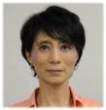 "Innovations in monitoring medical adherence in elderly patients in Japan"
"Innovations in monitoring medical adherence in elderly patients in Japan"
Dr Kiyomi Sadamoto
Professor
Department of Clinical Pharmacy
Yokohama College of Pharmacy
 "Nutrition and health maintenance in Japanese elderly"
"Nutrition and health maintenance in Japanese elderly"
Dr Hiroshi Shimokata
Professor
Graduate School of Nutritional Sciences
Nagoya University of Arts and Sciences
 "Adequate dietary intake in later life"
"Adequate dietary intake in later life"
Dr Yumi Kimura
Post-Doctoral Research Fellow of the Japan Society of the Promotion of Science
Center for Southeast Asian Studies (CSEAS)
Kyoto University
For more details:

WKC at the 12th IFA Global Conference on Ageing, 10-13 June 2014, Hyderabad, India
The 12th Global Conference on Ageing of the International Federation on Ageing (IFA) on the theme “Health, Security and Community” was successfully held on 10-13 June 2014 in Hyderabad, India, hosted by the Heritage Foundation, India. More than 300 delegates representing 49 countries participated- exploring, discussing and recommending actions on several sub-themes, inclusive of rights of older people; noncommunicable diseases; disability and ageing; quality of care and standards; income security; labour and workforce participation, age-friendly cities and communities; ageing in place; and innovations in care.
WKC Symposium:
"Driving Innovation for Ageing Populations: Results from WHO-commissioned studies of the needs of older persons for medical and assistive devices in 8 Asian countries"
Dr Jostacio M. Lapitan, Technical Officer, WKC, presented an “Overview of studies on needs, availability and affordability of assistive and medical devices for ageing populations in 8 Asian countries: Australia, China, Fiji, Japan, Malaysia, Philippines, Republic of Korea and Viet Nam” towards accomplishing the strategic objective of WHO: “to ensure the improved access, quality and use of medical products and technologies”. He concluded by emphasizing that: 1) these two systematic reviews and studies conducted in 2012-2013 were the initial work started by WHO in this field; 2) driving innovation for ageing populations has to be guided by the “Q (quality) and 5A principles” – availability, accessibility, acceptability, adaptability and affordability; and 3) research and further action must continue.
“Governments play a vital role in getting affordable assistive devices (AD) and medical devices (MD) to those who need it”, stated Dr Lloyd Walker, Director, Tech4Life. Reporting on the results of a recent survey on “Needs analysis on AD and MD for older people in six Western Pacific countries” concluded in February 2014. Dr Walker expressed gratitude for the technical support of WHO and the Ministry of Health, Labour and Welfare, Japan for funding the survey. He proposed that future work 1) continue to refine the methodology and implementation of the survey methods 2) validate survey results with samples of older people themselves; 3) effectively integrate AD and MD with other health services; and 3) educate and train professionals and communities on identifying which AD and MD they require, selecting, and maintaining them.

During the open forum that followed the presentations, participants appreciated the action research done in harnessing the uses of technological and social innovations to serve a rapidly ageing world. There was a lively discussion regarding the need for: 1) a “clearing house” on innovations for ageing populations; 2) standardization of nomenclature; 3) inclusion of gender-sensitive and user-responsive assistive devices (e.g., for cooking); 4) technological and psycho-social innovations for the elderly; and 5) innovations that are aligned to the six principles of “Q and 5As” that would be applicable to diverse settings and terrains (e.g., mountainous India and island states such as Maldives). The symposium was closed by the chair, Mr Ross, thanking all presenters and audience for the engaging and interactive exchange of ideas in the best interests of ageing populations.
Mr Ross presented in a plenary session, Life Course Immunization, on 12 June, providing an overview of “Vaccines for Older Populations: Knowledge, adaptation, implementation”. Mr Ross presented a comprehensive overview of the need, benefit and limitations of older persons accessing and using vaccines; the need to better understand underlying immunological science for older persons; adapting existing vaccines; as well as, paying attention to financing and increasing demand by older persons.
Presentations:
- “Introduction: Overview of the needs and gaps for medical and assistive devices for ageing populations: an agenda for innovation”
Mr Alex Ross, Director, WHO Kobe Centre (WKC)
- “Overview of studies on needs, availability and affordability of assistive and medical devices for ageing population in 8 Asian Countries: Australia, China, Fiji, Japan, Malaysia, Philippines, Republic of Korea and Viet Nam”
Dr Jostacio M. Lapitan, Technical Officer, Innovation for Healthy Ageing, WKC
- “Needs analysis on assistive and medical devices for older people in six countries in the WHO Western Pacific Region: China, Japan, Malaysia, Philippines, Republic of Korea and Viet Nam”
Dr Lloyd Walker, Director, Tech4Life, Australia
- "Technology model for Mobile Eldercare Unit (MEU) – Pilot project in Shimla District, Himachal Pradesh"
Mr Matthew Cherian, Chief Executive, HelpAge, India
- “Vaccines for Older Populations: Knowledge, adaptation, implementation"
Mr Alex Ross, Director, WHO Kobe Centre (WKC)
(At the plenary session on Life Course Immunization, 12 June 2014)
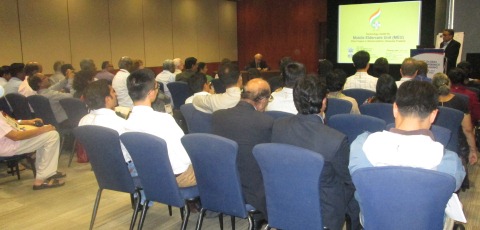
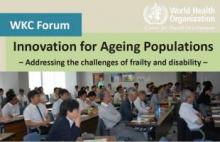
WKC Forum report: Innovation for Ageing Populations – Addressing the challenges of frailty and disability –
“Total innovative solutions addressing the challenges faced by ageing populations call for integrated medical, technological and social innovations that are universally accessible.” This was the concluding message of Mr Chapal Khasnabis, Technical Officer, WHO HQ Disability and Rehabilitation, Violence and Injury Prevention and Disability during his presentation at the WHO Centre for Health Development (WHO Kobe Centre - WKC) Forum held on 24 June 2014 in Kobe, Japan. Speaking to 76 participants coming from multiple sectors (i.e., hospitals/clinics, industry, research, universities, local governments, etc.), he presented an “Overview about innovative assistive technology for ageing populations: addressing frailty and disability” where he discussed the need for age-sensitive and knowledgeable, multi-skilled health service providers. He stressed the need for a paradigm shift in mindset as well as strategic processes that would result to assistive health products being: 1) available and accessible to communities; and 2) affordable, no matter who pays for
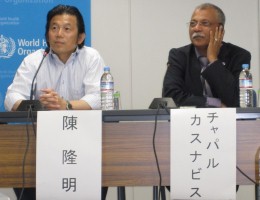 Dr Takaaki Chin, President, International Society for Prosthetics and Orthotics (ISPO), Japan, who focused on “Prosthetic walking for older lower limb amputees” introduced at first that the number of lower limb amputations globally for older populations has increased in recent years with critical limb ischemia as the cause secondary to peripheral circulatory failure due to arteriosclerosis and diabetes. Dr Chin is also the Director, Hyogo Institute of Assistive Technology (HIAT), Japan and Director, Robotic Rehabilitation Center of the Hyogo Rehabilitation Center, Japan. He stated that in Japan, there are 4000 reported cases of lower limb major amputations per year with two main challenges - improving the rate of preserving the knee joint and improving the success rate of rehabilitation post-amputation. In order to walk with prosthesis, older lower limb amputees must possess the following requirements: 1) motivation or the strong will to walk; 2) ability to put on (“don”) and take off (“doff”) the prosthesis which means in effect having good upper limb functions; 3) maintain standing position; and 4) physical strength for walking.
Dr Takaaki Chin, President, International Society for Prosthetics and Orthotics (ISPO), Japan, who focused on “Prosthetic walking for older lower limb amputees” introduced at first that the number of lower limb amputations globally for older populations has increased in recent years with critical limb ischemia as the cause secondary to peripheral circulatory failure due to arteriosclerosis and diabetes. Dr Chin is also the Director, Hyogo Institute of Assistive Technology (HIAT), Japan and Director, Robotic Rehabilitation Center of the Hyogo Rehabilitation Center, Japan. He stated that in Japan, there are 4000 reported cases of lower limb major amputations per year with two main challenges - improving the rate of preserving the knee joint and improving the success rate of rehabilitation post-amputation. In order to walk with prosthesis, older lower limb amputees must possess the following requirements: 1) motivation or the strong will to walk; 2) ability to put on (“don”) and take off (“doff”) the prosthesis which means in effect having good upper limb functions; 3) maintain standing position; and 4) physical strength for walking.
“The amputees are my teachers and the communities are my textbooks,” sagely narrated Dr Seishi Sawamura, Principal and Honorary Director of the Hyogo Rehabilitation Center, Japan, who spoke about “A short history of prosthetics and orthotics in Japan: Lessons gained from organizing community-based rehabilitation services”. Dr Sawamura explained that more than 50 years ago, Japan had neither the educational curricula nor medical and health-system wide activities for prosthetics and orthotics. In fact, there were very few hospitals which had prosthetics divisions. Yet, in Hyogo Prefecture, there were mobile counselling units at first providing rehabilitation services and support to people with disabilities in the countryside. It was through the home visits that the concept of community-based rehabilitation (CBR) was born, as the so-called Western methods of prosthetics and orthotics were considered not applicable to the traditional Japanese customs, such as not wearing shoes in the house and that of sitting on “tatami” mats. In 1968, a pioneering research group co-founded by Dr Sawamura was launched in Kobe and since then, a series of historical academic and legislative events occurred at prefectural, national and international levels - developing competency training programmes for relevant health workforce. Dr Sawamura ended his presentation by discussing and promoting “Community-based Inclusive Development” (CBID), levelling up from CBR, that no one should be excluded from development for any reason and that mutual cooperation among people in communities is critical.
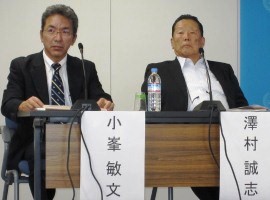 Mr Toshifumi Komine, Prosthetics and Orthotics Course Director at the Kumamoto College of Medical Care and Rehabilitation, Japan, elaborated on the basic role of a prosthetist as a professional responsible for the fitting required between humans and technical aids - from casting to adapting. In his presentation entitled “Experience of prosthetics and orthotics education in Japan: Introduction of technical aids education and its background”, he gladly shared that in Japan, as of April 2014, a total of 4470 candidates, who underwent a training course with technical inputs from medicine, engineering, sociology, prosthetics and orthotics, have successfully passed the national examination for prosthetists. He emphasized on the increasing number of Japanese people living with physical disabilities (approaching almost 3.9 million in 2012), 63% of whom were reported to be 65 years old and above; and the need for continuously improving or adapting technical aids, such as wheelchairs, in appropriately serving the needs of older populations – supporting proper posture, for example, while sitting on a wheelchair.
Mr Toshifumi Komine, Prosthetics and Orthotics Course Director at the Kumamoto College of Medical Care and Rehabilitation, Japan, elaborated on the basic role of a prosthetist as a professional responsible for the fitting required between humans and technical aids - from casting to adapting. In his presentation entitled “Experience of prosthetics and orthotics education in Japan: Introduction of technical aids education and its background”, he gladly shared that in Japan, as of April 2014, a total of 4470 candidates, who underwent a training course with technical inputs from medicine, engineering, sociology, prosthetics and orthotics, have successfully passed the national examination for prosthetists. He emphasized on the increasing number of Japanese people living with physical disabilities (approaching almost 3.9 million in 2012), 63% of whom were reported to be 65 years old and above; and the need for continuously improving or adapting technical aids, such as wheelchairs, in appropriately serving the needs of older populations – supporting proper posture, for example, while sitting on a wheelchair.The topics raised during the open forum, moderated by Dr Chin, touched on the specifics of inclusive development, team approach, health insurance and health research. The panel of speakers informed on the need to be aware of and disseminate about: 1) examples or models of CBID (e.g., projects in Fukushima, Japan); 2) the operationalization of an age-sensitive interdisciplinary team approach (e.g., prosthetists, occupational therapists, physical therapists working and learning together) that would prove beneficial to any patient, young and old; 3) health systems that include assistive health products in the national health insurance security scheme (e.g., ongoing initiative in the Philippines and the Long-Term Care Insurance Act of Japan, 2000); and 4) the need for evidence-based research, retrospective and prospective, involving, as much as possible, the views and preferences of older populations themselves as users and beneficiaries of assistive health technology.
The WKC Forum was closed with sincere gratitude to the coordination and support of the WKC Cooperating Committee and collaboration by ISPO, Japan and HIAT, Japan.

Presentations (Japanese)
- “Overview about innovative assistive technology for ageing populations: Addressing frailty and disability”
Mr Chapal Khasnabis, Technical Officer
Disability and Rehabilitation, Violence and Injury Prevention and Disability, World Health Organization (WHO)
- “Prosthetic walking for older lower limb Amputees”
Dr Takaaki Chin, President, International Society for Prosthetics and Orthotics (ISPO), Japan
Director, Hyogo Institute of Assistive Technology
Director, Robot Rehabilitation Center, Hyogo Rehabilitation Center
- “A short history of prosthetics and orthotics education in Japan: Lessons gained from organizing community based rehabilitation services”
Dr Seishi Sawamura, Principal and Honorary Director
Hyogo Rehabilitation Center
- “Experience of prosthetics and orthotics education in Japan: Introduction of technical aids education and its background”
Mr Toshifumi Komine, Prosthetics and Orthotics Course Director
Kumamoto College of Medical Care and Rehabilitation
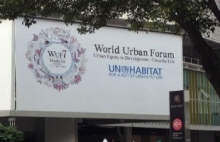
7th Session of the World Urban Forum (WUF-7)
The 7th Session of the World Urban Forum (WUF-7) was held 4-11 April 2014 in Medellin, Colombia. During the Forum, the WHO Kobe Centre held two networking events:
- Health equity and sustainable urban development in the post-2015 development agenda – Second WHO-UN HABITAT joint report
- Healthy and equitable urban planning through intersectoral action.
WHO Kobe Centre (WKC) also shared Centre’s work through the exhibition space.
The World Urban Forum is organized by the United Nations Human Settlements Programme (UN HABITAT) every second year. WUF is a non-legislative technical forum to examine the most pressing issues facing the world today in the area of human settlements, including rapid urbanization and its impact on cities, communities, economies, climate change and policies. WKC has closely collaborated with UN-Habitat since 2010 and shares a joint agenda of urban issues.
WKC sessions at the 7th World Urban Forum
At the 7th World Urban Forum, WKC organized two networking events: “Healthy and equitable urban planning through intersectoral action” and “Health equity and sustainable urban development in the post-2015 development agenda – Second WHO-UN HABITAT joint report”.
 Healthy and equitable urban planning through intersectoral action
Healthy and equitable urban planning through intersectoral action
8th April 2014, 8:30-10:00, One UN Room
Presenters of the session and links to the presentations:
- Suvi Huikuri, Technical Officer, WHO Kobe Centre, Japan: Healthy and equitable urban planning through intersectoral action for health
- Skye Duncan, Senior Urban Designer, New York City Department of City Planning, USA: Active design in New York City
- Bingqin Li, Associate Professor, Australian National University, Australia: Intersectoral collaboration and healthy urban planning in Jinchang, China: A case study
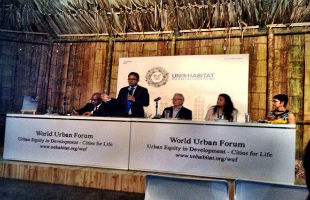 Health equity and sustainable urban development in the post-2015 development agenda
Health equity and sustainable urban development in the post-2015 development agenda
8th April 2014, 10:30–12:00, One UN Room
Links to the presentations:

